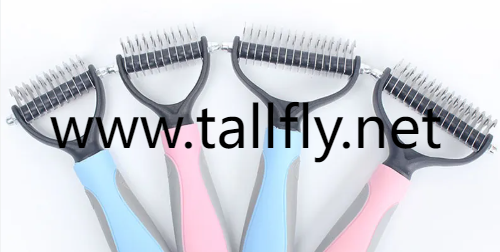Tallfly Notes On Durable Combs And Care For Tech Assisted Grooming

AI driven grooming tools are moving from prototype benches into everyday care routines, and pairing sensor feedback with a trusted detangler can change how owners respond to knots; a smart brush that highlights rising mat density and then prompts the handler to switch to a careful China Pet Knot Untying Comb makes interventions calmer and more precise. This combination answers a common problem: people want to protect coat and skin but can be unsure when to slow down, change angle, or ask for help. Real time sensing reduces guesswork and invites a more measured approach that respects an animal's comfort.
At the heart of the idea is clear feedback that keeps human hands steady. Sensors embedded in a groomer's handle read resistance and texture as the device moves across the coat. When a localized zone begins to show increasing density, the tool signals gently—through a vibration, a soft light, or a quiet tone—so the handler knows to pause and support the base of the knot. That cue helps avoid sudden pulling, which can make sensitive animals recoil and make future sessions harder. A subtle prompt in the moment teaches good technique as much as it prevents harm.
Shelters and rescue networks stand to gain from sensor aware grooming because intake animals often arrive with neglected coats. Volunteers with limited grooming experience can follow device guidance to triage tangles: slow detangling for manageable mats, or a professional trim when a mat is fused to skin. This decision path saves time, reduces accidental injury, and helps prioritize cases that need immediate veterinary attention. When volunteers report calmer animals after sessions, community teams are more likely to keep grooming as part of intake care.
Designers working on these tools focus on three practical constraints. The sensors must tolerate frequent rinses and drying, they need to be robust against knocks and drops, and the feedback must be simple to act upon. Complex readouts or ambiguous alerts create confusion in the middle of a session; straightforward cues are easier to follow. That simplicity extends the reach of the technology to owners who want help but do not want to learn a new technical vocabulary.
Integration with instructional content increases usefulness. A companion app or a short embedded tutorial can show a one minute clip that demonstrates the exact response a device is prompting: anchor the base, tease outward with short strokes, switch to a detangler and finish with a gentle smoothing pass. These micro lessons, delivered at the moment of need, help less experienced handlers translate a prompt into a safe action. Over time, owners internalize the rhythm and rely on sensors less because their hands learn to sense rising density themselves.
Privacy and data practice deserve attention as these devices collect tactile signals. The simplest design stores only brief, local logs that help the owner understand a recent session and that are erased by default. Manufacturers who avoid cloud storage of raw sensor traces and who provide optional, anonymous aggregation for product improvement address reasonable user concerns. Families welcome assistance but tend to resist continuous monitoring, so transparency about data use encourages adoption.
Cost and serviceability determine how widely these tools spread. A model that requires full replacement after a fault will frustrate users and shelters alike. Modular designs, with removable electronics that clip out for servicing while the comb head rinses clean, extend useful life and lower repair costs. Durable materials for teeth and tips resist burrs and preserve the gentle glide that reduces pulling. Those choices matter for busy households and for organizations that groom many animals.
Community validation helps adoption. When volunteer groomers and small business owners share short stories of calmer sessions and fewer emergency trims, others notice. Demonstrations that show a real rescue dog or a nervous cat settling under guided handling translate technical claims into lived outcomes. That peer to peer sharing accelerates confidence and teaches quick, effective habits that keep animals comfortable.
Vets and professional groomers contribute essential calibration. Their input on safe threshold levels for alerts and on recommended responses helps producers tune devices so that prompts reflect safe handling rather than rigid rules. Collaboration between technicians and practitioners anchors the product in care standards and avoids accidental harms that arise from poorly chosen defaults.
Tallfly has observed growing interest in tools that pair human skill with helpful nudges, and the brand's approach emphasizes clear maintenance guidance and accessible use notes so owners and caregivers can adopt sensor assisted routines with confidence. For those who want to explore models that support calm detangling and to review practical care instructions and product features, detailed information and usage guidance appear at www.tallfly.net/product/ which offers descriptions that help match tools to living situations and grooming rhythms while encouraging gentle, informed interventions.

